Intel Core i7 4960X (Ivy Bridge E) Review
by Anand Lal Shimpi on September 3, 2013 4:10 AM EST- Posted in
- CPUs
- Intel
- Ivy Bridge
- Ivy Bridge-E
Memory Performance
Seeing as how the huge L3 cache and quad-channel memory interface are big parts of what makes Ivy Bridge E unique, I thought it might make sense to look at memory latency and bandwidth. We'll start with memory latency, compared to Ivy Bridge, Haswell and Haswell + Crystalwell.
The larger L3 cache buys IVB-E lower latency accesses for a wider range of addresses, but once you exceed the 15MB L3 cache space we see latency about on par with everything else. Only Haswell + Crystalwell manages to hold out for longer. Unfortunately that's not really a part desktop enthusiasts can buy so it's mostly an academic comparison.
The bandwidth story is an interesting one. Sandra maxes out bandwidth by driving all cores at the same time, so you get some uplift here by there simply being more cores under IVB-E's hood. But even if you divide out the number of cores, you get per core cache bandwidth figures that are extremely high (at least outside of L1). The L3 cache in particular is quite bandwidth happy.
Going outside of the L3 cache, we also see a doubling of memory bandwidth - which is expected given the doubling of memory interface width. In reality the peak memory bandwidth advantage would be even larger as IVB-E officially supports DDR3-1866 (if you only populate 1 DIMM per channel, otherwise either 1333 or 1600 is officially supported).
General Performance
I don't know that I've ever seen an Intel slide before that called out a performance degradation, but there's a first time for everything:
The problem with IVB-E vs. Haswell is that the extra large L3 cache and quad-channel memory interface are generally only useful in heavily threaded applications, which of course benefit from its 6-core configuration. In those tests that aren't heavily threaded however, IVB-E typically sees a single threaded performance deficit compared to Haswell. Given that the 4960X and Haswell based Core i7-4770K run at very similar frequencies, it's not surprising to see IVB-E take a backseat to Haswell in in "everyday computing" tasks. Intel's slide above claims about a 18% reduction in "everyday computing" performance compared to the 4770K, but in practice I found the gap to be much narrower.
Although not the best indication of overall system performance, the SYSMark 2012 suite does give us a good idea of lighter workloads than we're used to testing.
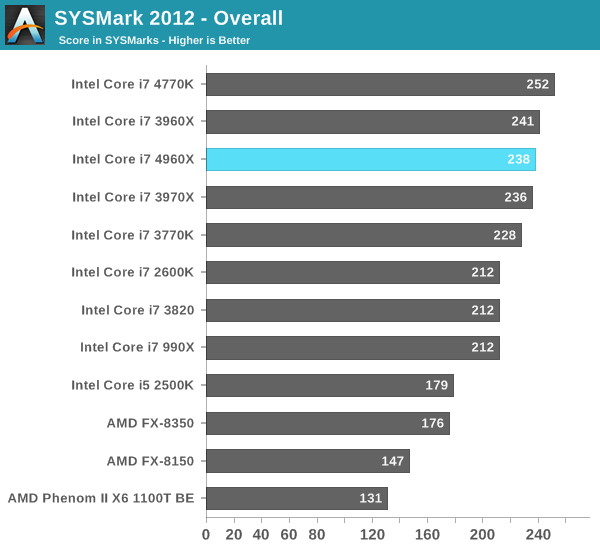
There's pretty much no advantage to the 4960X over the 3970X here. Remember Ivy Bridge's architectural improvements were very limited on the CPU side. As clock speeds didn't really go up between the 3970X and 4960X, the performance parity here isn't surprising. Haswell manages a ~6% performance advantage over the 4960X at an obviously lower power and price point.
Although I retired SYSMark 2007 a while ago, I do have much older performance data here which lets us compare the 4960X back as far as the early Pentium 4 based Extreme Edition parts:
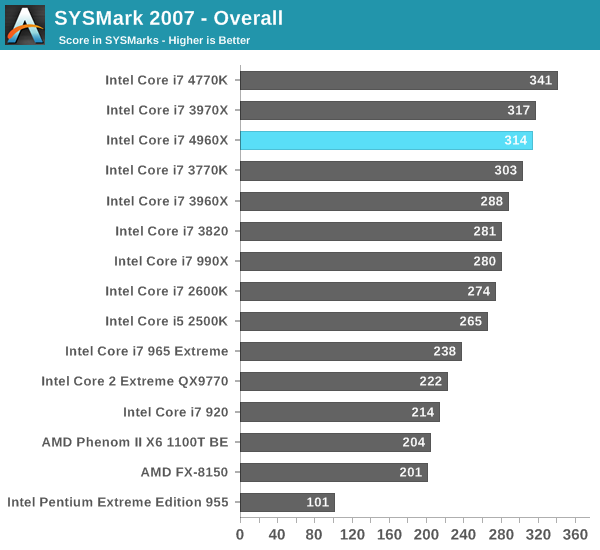
The Haswell advantage grows a bit here to around 8%, but the 4960X remains in the top three performers here. It's very clear that for most users, there are far more cost effective ways of getting great performance than IVB-E.
Our final lightly threaded test is Mozilla's Kraken JavaScript benchmark. This test includes some forward looking js code designed to showcase performance of future rich web applications on today's software and hardware. We run the test under IE10:
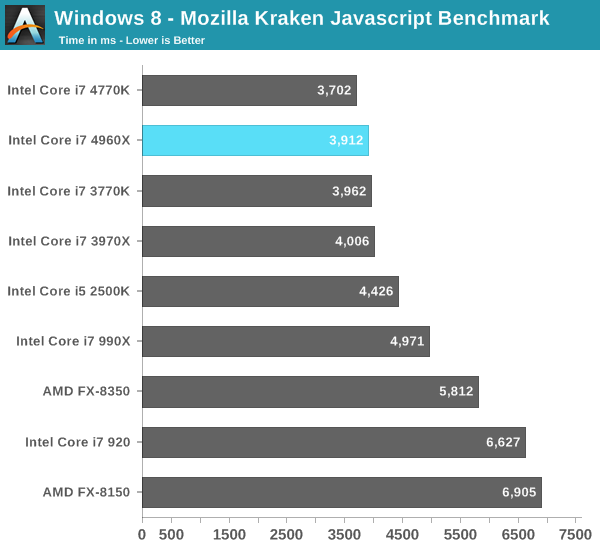
Ivy Bridge always had good single threaded performance, but once again these lightly threaded use cases are better served by an architecture with higher IPC. The Haswell advantage isn't huge, but it's a lower power/more cost effective way to get the best performance here.
If you are still on LGA-1366, you'll note that the performance gains here are good, but not earth shattering. Comparing to Intel's first 6-core platform, the 4960X manages a 27% increase in performance over the Core i7-990X. That's a healthy gain, but it's still small enough where there's no immediate need to upgrade.


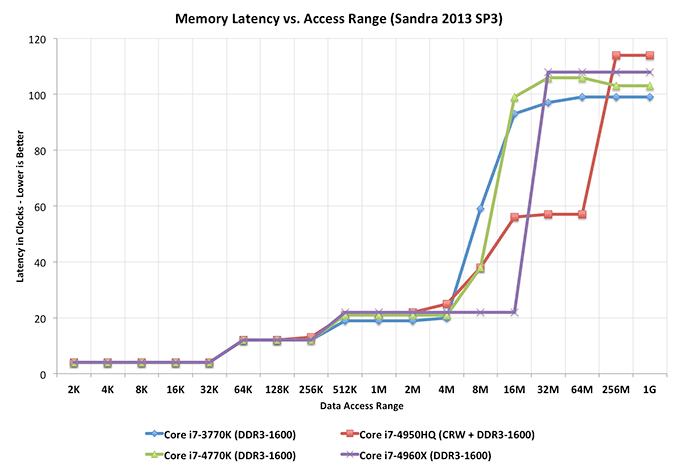
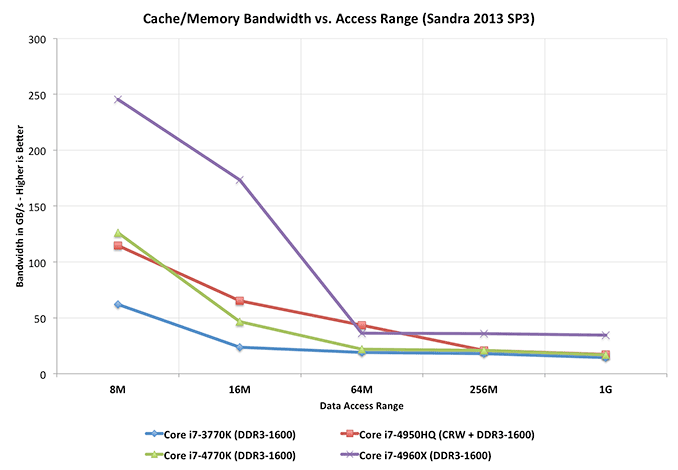
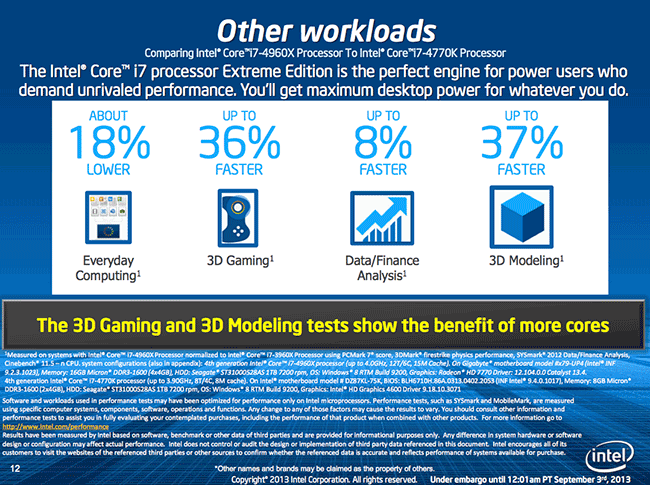








120 Comments
View All Comments
Snoopykins - Tuesday, September 3, 2013 - link
Excellent review. I must say the reviews Anand himself writes always seem to be spot on. One question, where does the 22 months number come from? Is that the scheduled/rumored/leaked release date of Haswell-E? If so, isn't that going to be even more behind than Ivy-E? I'm assuming Skylake will have been out for longer than Haswell has been out now, no? Also, do we know that Skylake will support DDR4? I've heard Haswell-E will.Anywho, thanks for the excellent review, I thoroughly enjoyed it.
eiriklf - Tuesday, September 3, 2013 - link
22 months is about the time between the releases of sandy bridge extreme and ivy bridge extreme1Angelreloaded - Tuesday, September 3, 2013 - link
Haswell-e will if they move to a new socket and board DDR4 probably won't be compatible with DDR3 DIMM sockets.hrrmph - Tuesday, September 3, 2013 - link
Yep, that was a great review.It's not often that I think that a review really nails it all (at least for what I need), but this one did it. Very balanced, taking shots at the weak points, while also thoroughly explaining what is good about it, and who it might benefit.
X79 is adequate only if you are willing to load your machine up with lots of add-in controller cards.
Intel will really need to up their game on the chipset when Haswell-E gets here.
jasonelmore - Tuesday, September 3, 2013 - link
most modern x79 boards have all the add on controllers soldered onto the motherboard. Cards are not needed.just4U - Friday, September 6, 2013 - link
With so few new things coming out in the desktop division these days Im sure Anand is quite fine to getting back into the trenches to do the odd review. Used to be (or so it seemed) every other day we were getting glimpses at exciting new things but these days that appears in the form of tablets and smartphones /w the desktop industry being somewhat stagnant in my opinion.dishayu - Tuesday, September 3, 2013 - link
At this rate, as Anand suggests, Haswell-E will come out around/after Skylake based Desktop parts(assuming that is still on track for 2015 release). I am convinced that it would have been a better approach to skip Haswell-E altogether and jump straight to Skylake-E in 2015. This logic is further supported by the fact that next gen will require a new socket design (since Haswell comes with FIVR).jasonelmore - Tuesday, September 3, 2013 - link
there is still a node jump to go through. Most of the time this delays projected release dates. Broadwell may be late.Kevin G - Wednesday, September 4, 2013 - link
Since there is going to be a Haswell refresh in 2014, I'd expect Haswell-E to be introduced around the same time: roughly a year from now. The delay of Broadwell on the desktop will allow Haswell-E to catch up in cadence a bit.The new question is when Broadwell-E will arrive: with Skylake or vanilla Broadwell on the desktop?
f0d - Tuesday, September 3, 2013 - link
nice cpu for those that have an older platform (like 1156 or 1366 maybe) but as someone that already owns a 2011 socket cpu im still hoping they will eventually release 8 or even 10/12 core cpu's so i can encode vids fastercmon intel release those 8/10/12 core cpu's for the enthusiast platform.!